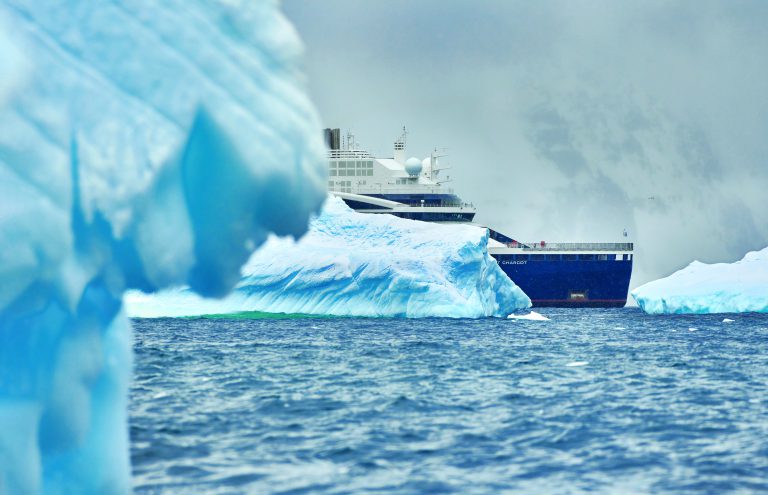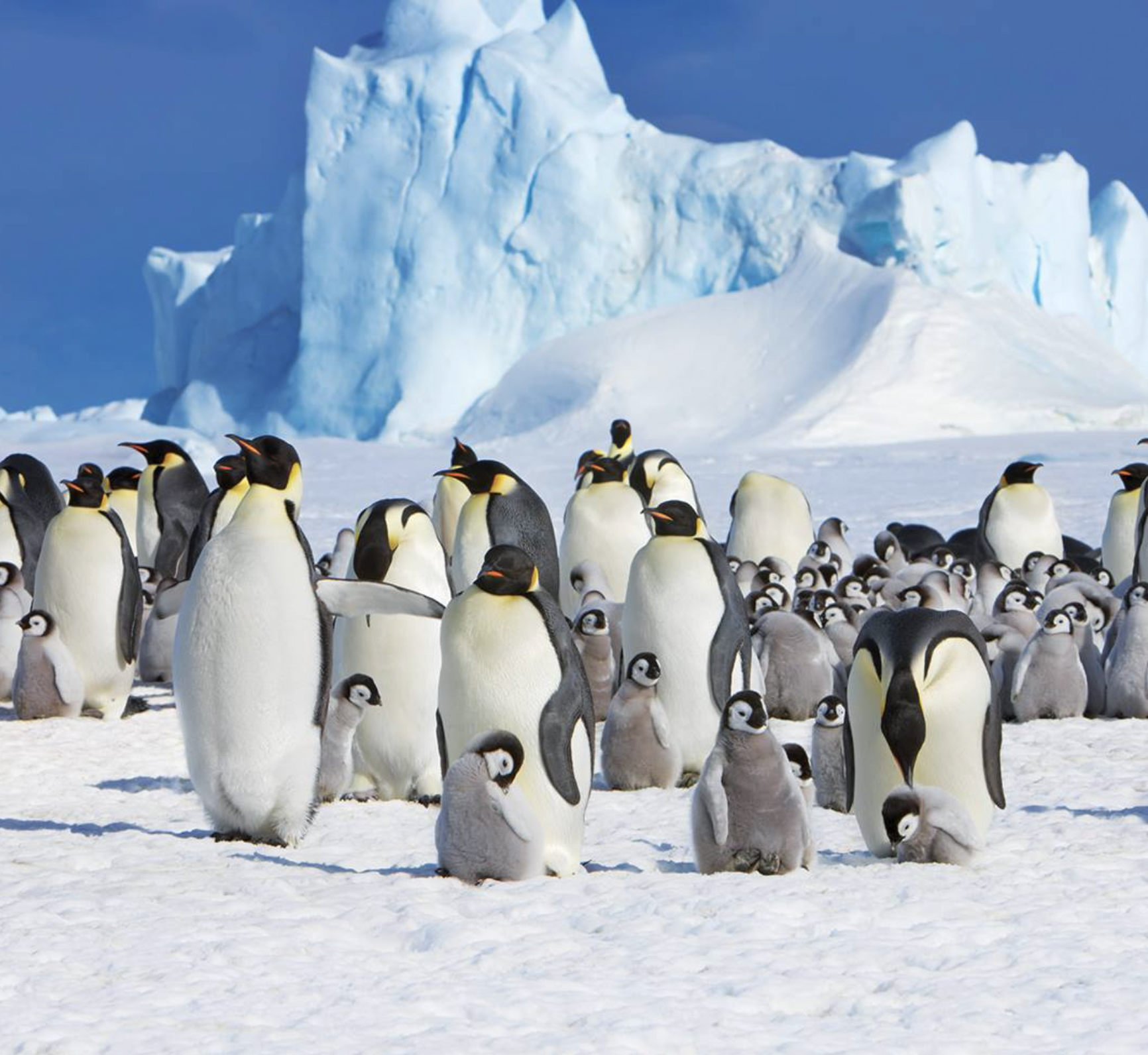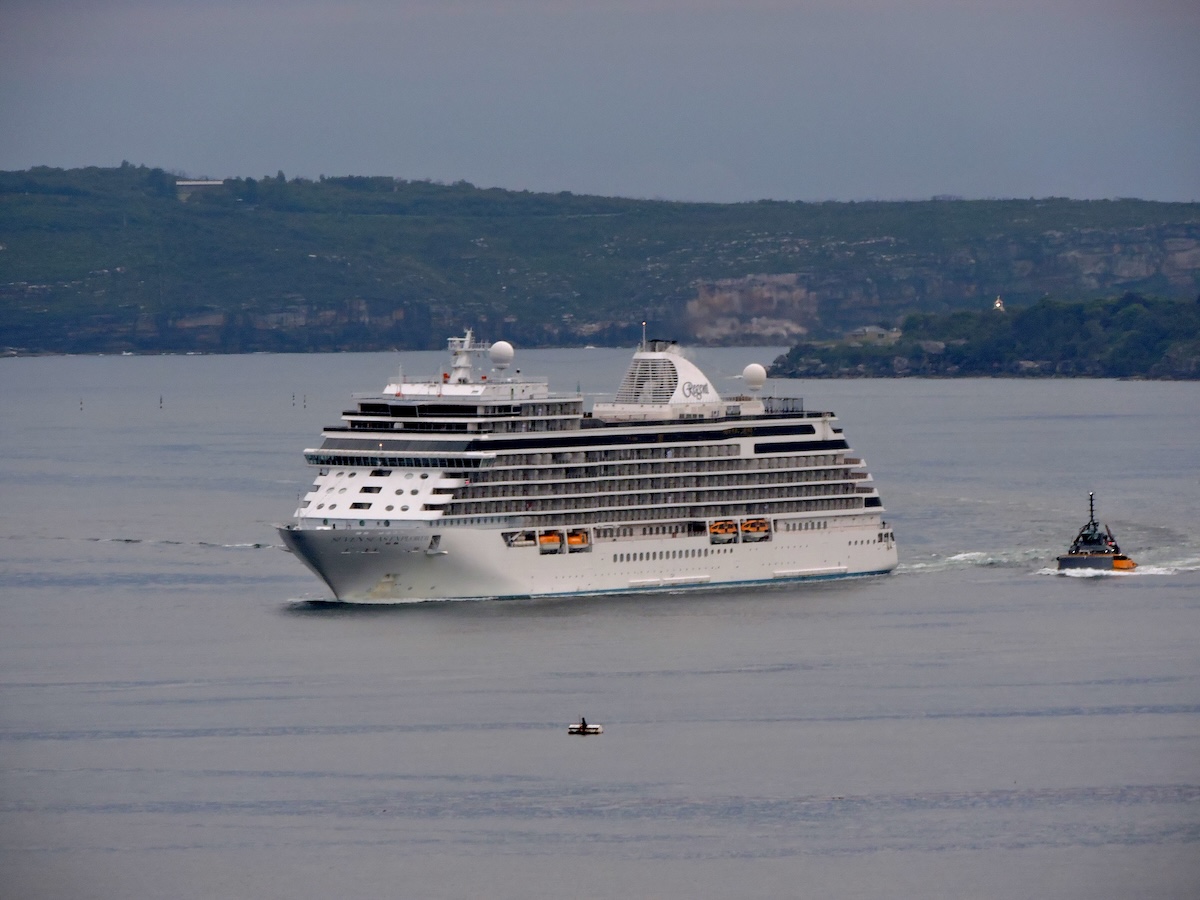“Ice permitting, we’re going to do something no other passenger ship can do,” says Etienne Garcia, the captain of Le Commandant Charcot. This is a ship like no other, built to sail all the way to the geographic North Pole, and explore Antarctica much further south than anyone else.
We have just left Punta Arenas in Chile, heading for Antarctica, and during our first briefing we find out more about Le Commandant Charcot. “Our ship is named after the French explorer Jean-Baptiste Charcot, who at the start of the 20th century charted large parts of the Antarctic Peninsula with his ship, the Pourquoi Pas? [Why not?],” explains Captain Garcia. “More than 100 years later, we will be the first passenger ship to follow in its wake.”
It will take us more than two days to cross the infamous Drake Passage, navigating between two storm depressions so we can drink in the full luxury ship experience. We’re amazed at all the clever features we find on board, like the heated outdoor seats, snow cabin, stylish design elements, faux fireplace, panoramic outdoor pool and more.
But time is precious. During the crossing, we get several briefings. We need to know the rules of the IAATO (International Association of Antarctica Tour Operators), so we can limit our impact on the environment. This includes, for example, the process of disinfecting boots to prevent microorganisms travelling from one island to another. The briefings also answer questions such as how close you can you get to the penguins. Ponant is very strict about this. And rightly so.
These days at sea in the Drake Passage are also essential to mentally prepare yourself for Antarctica. Heading along the tidal inlet from Punta Arenas, we can already feel it: we’re closing the door of the world behind us, heading for a new planet, another universe.

Crashing through the ice pack
And before we know it, it’s happening. We’ve left behind the open sea and are now cutting through the ice. We’re in Antarctica! In the frozen desert that is the Matha Strait, we don’t know where to look first. As the ship ploughs deeper into the icy bay, the scenery gets more and more unbelievable with every passing hour.
Le Commandant Charcot can handle a lot. The ship is built as an icebreaker, with lots of spare engine power and a special hull. For example, the engine room is positioned much further forward, so that the weight of the ship helps to pulverise the ice. If required, it can sail through sea ice more than two metres thick. Special screws can also be used to crush the ice. The ship even has a second bridge at the rear, in the event that navigating backwards is the only option.
It’s incredible. All the ice closes up again behind us, as if we were never there.
The vessel is unique: it is the first hybrid expedition ship where the Azipods (large manoeuvrable propellers) are run on electric power from generators (liquid natural gas or diesel) and large battery rooms. The LNG tanks are so big that the ship has enough fuel to last a month.
It is also a surprisingly quiet ship. We walk all around Deck 5 to an almost mystical silence. We hear the cracking of the ice, the crunching of the snow. There is a humble silence among the few passengers outside, who whisper like they’re in a shrine.
“Ladies and gentlemen, look at that, what a spectacle,” the captain exclaims. The emotion in his voice tells us we’re not the only ones who can barely believe it. He’s right. We glide slowly through a dreamlike landscape. Cathedrals of ice dominate the ice plain. Here and there we spot seals sleeping peacefully on the ice.
The plan is to step ashore on Jenny Island. From the Zodiac we see colossal elephant seals on the snowy beach. Most of them are asleep. Some of the youngest are having a play-fight. Typical Antarctica: the weather changes in a flash. A small snowstorm hits and the waves swell. We won’t be going ashore. The idyllic landscape has suddenly turned into a frozen Jurassic Park.
We sail past the British Antarctic Survey base of Rothera and see the Sir David Attenborough, the brand-new research ship that has just arrived. It will be the only other ship we see the whole trip.
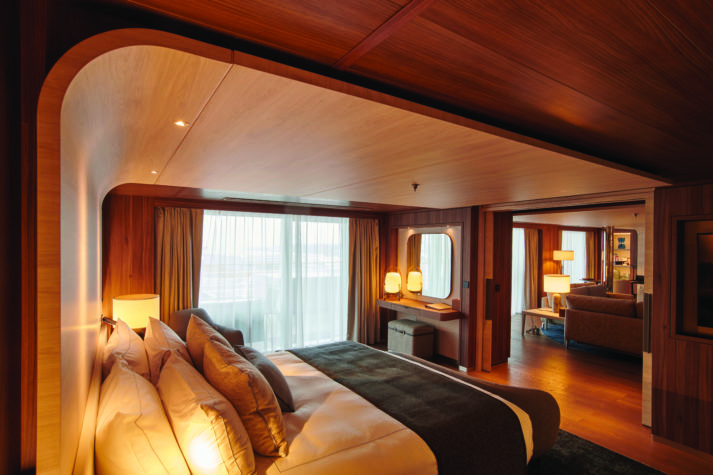
Exploring Hanusse Bay
The captain skilfully navigates through the Gunnel Channel, a hallucinatingly beautiful bottleneck in the snowy mountain landscape. Some of the peaks are over 2,300 metres high. It’s
a real feast for our eyes. We pace up and down enthusiastically on the helicopter deck.
“Cormorants, starboard side! An iceberg, port side!” Everyone is excited. It’s getting even better.
In the late afternoon, Captain Garcia ‘parks’ the ship in the ice of Hanusse Bay, yet another incredible experience. From the observation deck we see the nose of the ship sticking out of a blinding white expanse of ice and snow. The sky is deep blue. The gangway is lowered so passengers can go for a walk on the fast ice.
While we’re getting ready (complete with thick socks, merino wool base layers, a parka, etc), from the balcony of our suite we see the first group of passengers stepping onto the white surface. There’s a touching moment as we watch a welcoming committee of local chinstrap penguins come to greet the strangers. Humans and penguins check each other out from a distance, separated only by a break in the ice. Reassured, the penguins settle down next to our ship for the night.
Not long after, we’re also on the snow-covered ice. We had signed up for a snowshoe hike, with Jacques as our guide. For many years, Jacques was assistant to the famous photographer Sebastião Salgado.
It takes a bit of getting used to, walking through the snow with these clumsy things on our feet. The scenery is phenomenal. We can barely believe it is real.
The kitchen knew we’d be back late. No problem: they just adapt. At 10pm there’s still a delicious buffet for us to tuck into. The huge iceberg in the distance turns pink.
It is only two days since the longest day of the year. The sun won’t set tonight, but at most disappear behind a mountain for a while. It’s midnight. We keep an eye on the penguins sleeping below us. Then we also bed down for the night, our ship safely guarded by the ice of Hanusse Bay.

Helping out with citizen science
The next day we try out some of the citizen science activities. “Ponant wanted to give science a helping hand,” explains scientific mediator Daphné Buiron. “We have
a real lab and measuring equipment on board, which we make available for scientific projects. We also want to get the passengers involved in scientific work by letting them actively help out with measurements and observations.”
Daphné teaches us how the thickness of the ice and the layer of snow is measured. Before that we learnt how to upload photos of the tail of a humpback whale to the Happywhale app. Each tail fluke has
a unique pattern of pigmentation that acts like an ID. This lets you see whether ‘your’ whale has been spotted before.
Le Commandant Charcot is like a luxurious cocoon protecting us from the rugged, inhospitable Antarctic landscape. Sometimes we stand outside for hours, wrapped up in
the orange parka that every passenger gets. Until it’s time to eat, and we’re served mouthwatering dishes. The floor-to-ceiling windows in the buffet restaurant on Deck 9 make this the place to be.
Champagne, oysters, foie gras, beautifully presented dishes… with renowned chef Alain Ducasse’s team behind the gastronomy, there is no doubt this is a French ship. We’re not normally dessert people, but we can’t resist what the on-board pastry chef is conjuring up.
As if we weren’t already being pampered enough, the kitchen crew really pushes the boat out on Christmas Eve. The transition from orange parka to suit and tie is wonderfully surreal. Especially when Santa Claus is brought on board in a Zodiac.
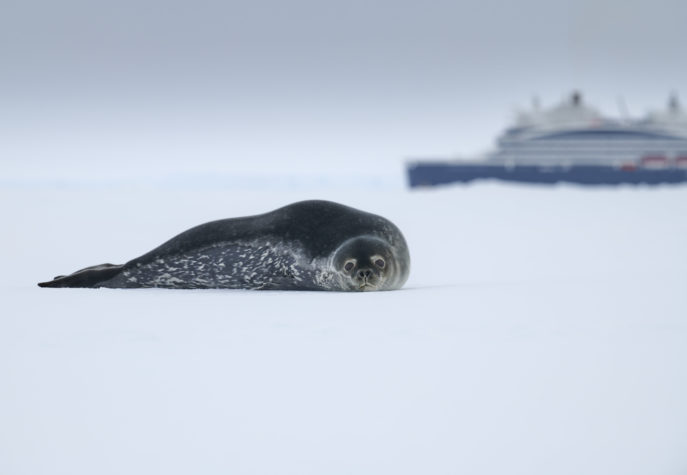
Entering another world
Charcot Island has to be the highlight of the trip. From the bridge, Captain Garcia puts his heart and soul into his storytelling. His voice swells with excitement and pride, describing the tabular icebergs with the enthusiasm of a little boy tugging at his mum’s sleeve. Expedition leader Florence Kuyper is also thrilled to be able to share this adventure with her passengers.
Slowly, the ship penetrates the brash ice. The light is incredibly bright, the whiteout making sunglasses essential.
Olivier, the helicopter pilot, prepares for a reconnaissance flight with an officer to get a better view of the best and safest route to take. (The helicopter isn’t for passengers.)
When the ship is firmly secured in the fast ice at the edge of Charcot Island, we head out for another walk. We choose the longest hike. It’s not cold, maybe just below zero. The icy landscape is dotted with protrusions that look like frozen shark fins. Are we still on planet Earth? The halo around the sun, the sleeping crabeater seals, our ship that in the distance looks like it’s floating in a white horizon-less landscape: the whole thing has everybody spellbound. We might be quiet, but inside our hearts are singing with joy.
The next day we continue sailing southwards, deeper and deeper into the frozen landscape. Laura Jourdan, the seal specialist on the expedition team, is elated when we spot the very rare Ross seal. The captain immediately cuts the engine so we can observe the animal up close. The seal seems to be lapping up his 15 minutes of fame, rolling around in the snow like a fashion model.
Then comes Captain Garcia’s moment of glory: we have crossed the 70th parallel south. Sailing further south than anyone else on Earth at this time of the year – this is perhaps Le Commandant Charcot’s greatest luxury.
Looking back at the wake, it looks like the captain has drawn a question mark in the ice with his ship. A tribute to his fellow explorer Jean-Baptiste Charcot, perhaps it is the question mark of the Pourquoi Pas?

